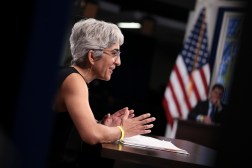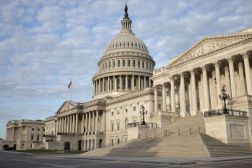Agency leaders anticipate a post-pandemic hybrid work environment

As many federal employees inch closer to one year of working remotely during the COVID-19 pandemic, there is an undeniable workplace culture shift emerging: Even as vaccines could make in-person work possible again, many federal workers may still ask to work remotely full time.
The result could be a hybrid workforce more evenly split between in-person and remote employees than it has been in the past, federal IT officials told FedScoop.
“I expect after COVID that more people will appreciate working remotely and a higher portion of our workforce may want to work remotely,” National Science Foundation CIO Dorothy Aronson told FedScoop. “I would anticipate that we’ll need to look very closely at those hybrid meetings, where some people are in the office and some people are at home, to even out that interaction.”
Lessons from this prolonged period of telework that began last March — both technological and social — will be important to implement in the new normal.
“I believe that a lot of the things that we’ve learned through the COVID pandemic, once we’re on the other side of it, we’re going to continue to embrace more telework, more virtual, better use of technology in order to engage,” Stacy Cummings, the principal deputy assistant secretary for acquisition at the Department of Defense, said during a Jan. 13 panel organized by AFFIRM. Cummings has taken over as the Pentagon’s acquisition lead in an acting capacity under the Biden administration until that role is filled.
An October 2020 survey of 300 federal government executives from the Science Applications International Corporation found that 82% of respondents expected to telework at least three days per week after the pandemic.
Of course, such a change would require agency leaders and the new administration to embrace the new trend as well. Prior to the pandemic, the most recent federal data showed 42% of employees across government were eligible to telework, and just half of those actually did. And most often, they teleworked on a situational basis. When they did telework regularly, roughly a third of those eligible did so three or more days a week.
The NSF is one agency that already had robust telework and hybrid work policies set up prior to the pandemic— a result of a 2017 headquarters move that forced continuity of operations planning in case equipment and technology got lost in transport.
One-third of the organization had already been working remotely at least one day a week before the pandemic, Aronson said. Not only did this help the organization switch to complete telework with little fuss, but it gave leaders a glimpse into the potential challenges of a hybrid workplace.
“You want the conversation to be balanced,” she said. “You become a moderator of the meeting, and you have to make sure that you’ve heard the voice of everyone in the engagement.”
To make it work, employees in both the conference room and the living room need to communicate in “an optimal way that is fair and inclusive.” She said that just as workers figured out equitable communication in an all-virtual space this past spring, they will have to write and then re-write the rules of engagement for hybrid meetings.
“What happens in the future if someone wants to come in through [Microsoft] Teams and someone else wants to come in through Zoom and you have three people in the room? How do you work that scenario? Process is a very important part of how we work,” she said.
It is a challenge that leaders across the federal government are anticipating.
“One of the things we have to prepare for is the democratization of access,” Vaughn Noga, the chief information officer at the Environmental Protection Agency, told FedScoop. “One of the things that we’re really focused on is making sure that we don’t have a disparity of experience.”
That disparity, however, may be inevitable. During that same Jan. 13 AFFIRM panel, Beth Anne Killoran, deputy chief information officer for the General Services Administration, quipped that it will take much more than additional collaboration tools to put everyone on an even playing field.
“You’re going to have to move to virtual reality,” she said. “The only way you’re really going to have the same experience is if you all have a virtual reality experience so it’s like everybody is in the same space doing the same types of things.”
Obviously, federal agencies are not yet equipped to deploy that kind of technology. For now, they are relying on software like Zoom, WebEx, Teams, Google’s G-Suite, Slack and others to connect the workplace and working to permanently integrating them into workflows.
“We view 2021 as a year of opportunity for Zoom because as our government customers are evolving in line with this new normal, we’re going to be a key partner for them as they modernize their information technology and in turn increase productivity, lower costs and strengthen security for their organization and workforce,” Matt Mandrgoc, Zoom’s head of U.S. governments, told FedScoop. Zoom’s simplicity and ease of use, he said, are key factors in making remote and hybrid work functional.
Noga said the EPA is working on implementing collaboration technologies so that everyone has the same experience, whether working from home or not. The goal is to seamlessly integrate teleworking employees into how meetings are executed. That means updating videoconferencing equipment, ensuring strong network bandwidth and continuing the technological education that the pandemic accelerated.
“I think that’s one of the largest parts. It’s not always the IT or the technology. It’s how you train and support folks who may not be IT folks to use this technology,” he said. “We spent a lot of time on training to make sure people understand on their terms.”

This story was featured in FedScoop Special Report: The Future of Telework - A FedScoop Special Report






